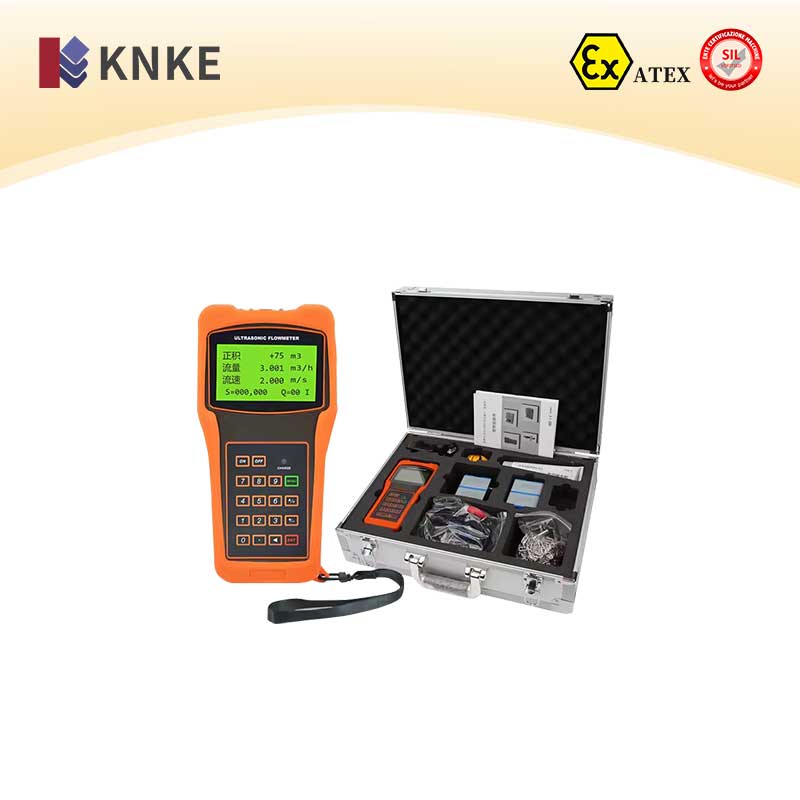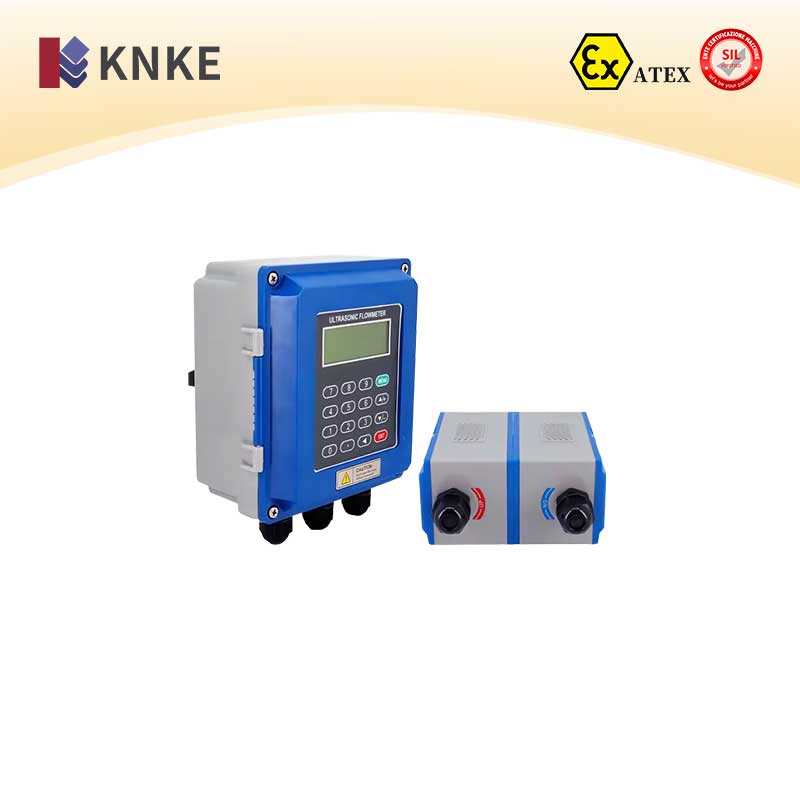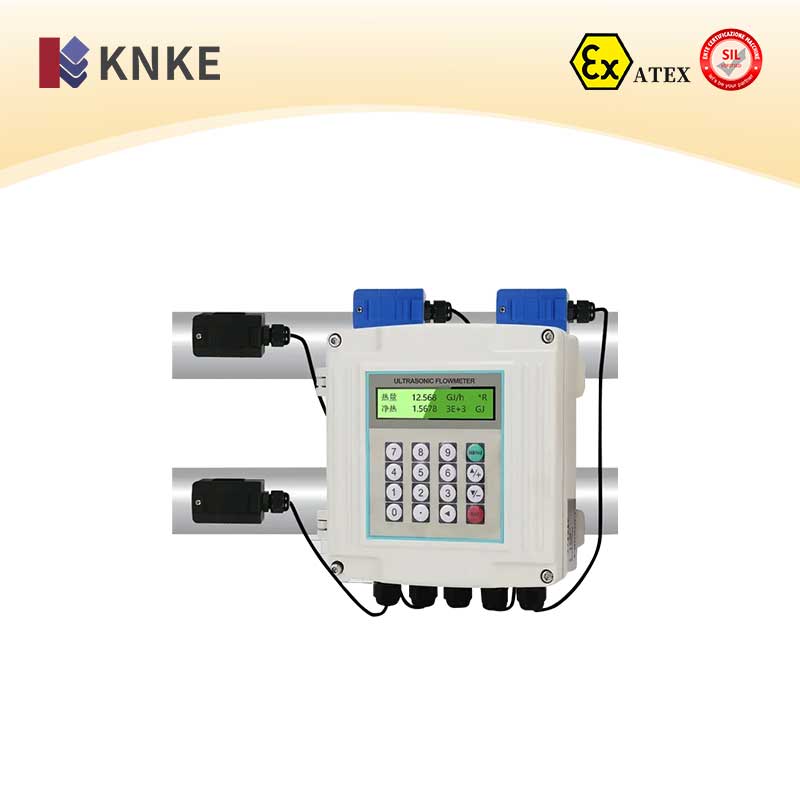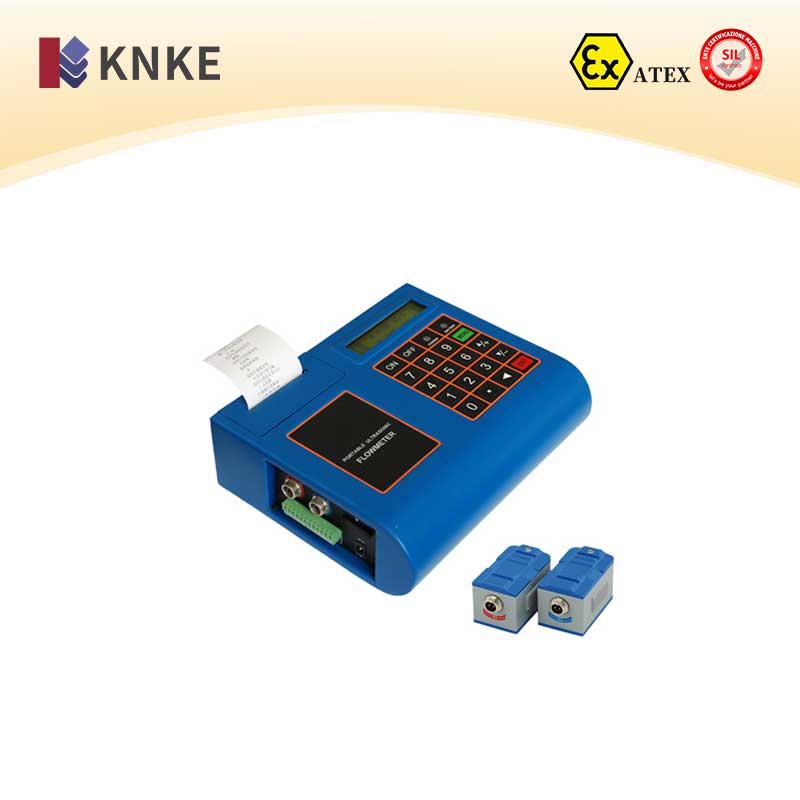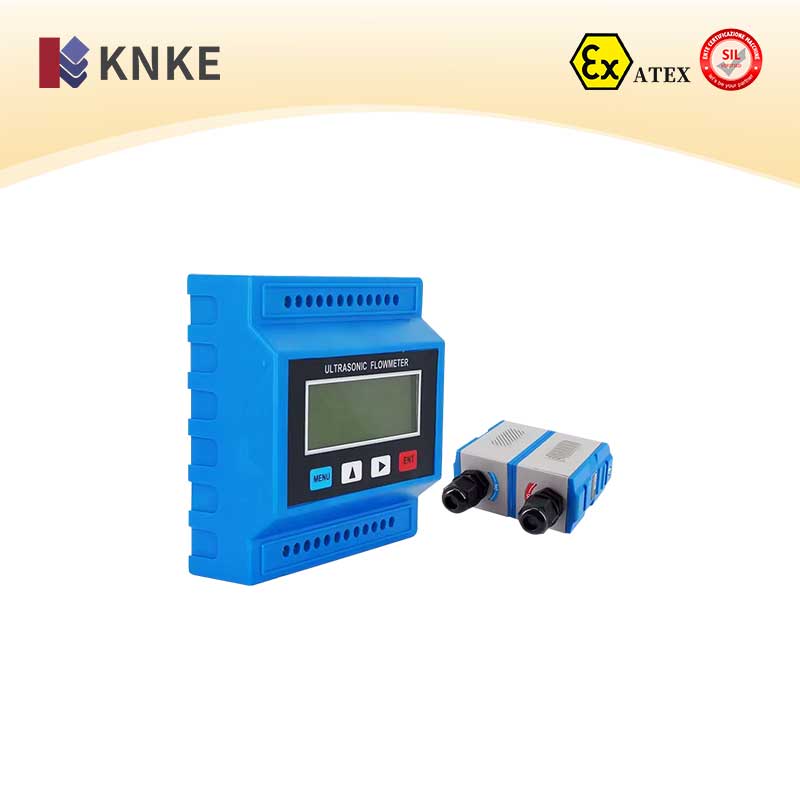Description
1. Overview of the KNKE Ultrasonic Flowmeter
The KNKE ultrasonic flowmeter uses advanced technology to measure fluid flow. It applies the principle of sound wave propagation. A pair of temperature sensors are placed on the upstream and downstream pipes. The flowmeter emits pulse signals proportional to the flow rate. It uses multi-pulse technology, digital signal processing, and error correction technology. These features ensure high-precision measurements, making the flowmeter suitable for industries such as oil, chemicals, metallurgy, power generation, and water supply.
2. Ultrasonic Flowmeter Signal Detection Principle
The ultrasonic flowmeter uses several methods for signal detection. These include propagation velocity difference, Doppler, cross-correlation, and more. Like electromagnetic flowmeters, ultrasonic flowmeters have no mechanical parts. This makes them ideal for large-caliber flow measurement. Their rapid development and precision make them highly effective in challenging measurement environments.
3. Technical Features of the Ultrasonic Flowmeter
- Patented Transducer Technology: Advanced transducers and electronic technology ensure accurate and stable flow measurements.
- No Moving Parts: Measurement accuracy is not affected by usage, and maintenance costs are low.
- Corrosion-Resistant Construction: Stainless steel housings ensure stable flow characteristics and minimize pressure loss.
- Multiple Communication Options: The flowmeter supports infrared, RS485, and M-BUS for remote data transmission and centralized control.
- Automatic Fault Diagnosis: The device features automatic error detection and reporting.
- Easy Installation: Available in external clamp, pipe segment, or insertion types, making installation flexible for different conditions.
- High-Temperature Applications: The flowmeter can be customized for high temperatures (up to 130°C).
4. Design Features of the Ultrasonic Flowmeter
- Convenient Installation: The external clamp type allows installation without cutting pipes. Simply clamp the sensor to the pipe surface, and the flowmeter detects flow using ultrasonic waves. This installation method avoids pipeline damage or leakage, which is especially useful for corrosive fluids.
- Wide Turndown Ratio: Ultrasonic flowmeters have a turndown ratio up to 100:1. Some models can even reach 500:1, enabling accurate measurements across a wide range of flow conditions.
- Low Flow Start-Up: Ultrasonic flowmeters work well at low flow rates. They are ideal for small pipes, where traditional flowmeters may not perform accurately.
- High Accuracy: The accuracy of ultrasonic flowmeters exceeds that of mechanical flowmeters, particularly in high-precision applications.
- Low Power Consumption: These meters require very little power, with built-in batteries lasting 6 to 10 years.
- Portable Flow Measurement: Due to their low power consumption and clamp-on measurement, portable ultrasonic flowmeters offer convenience for on-site testing. The battery can last up to 16 hours.
- HVAC Energy Management: Ultrasonic flowmeters provide precise energy measurements, particularly in HVAC systems. They help monitor water energy, reduce energy costs, and avoid pipeline damage.
- Low Operating Costs: While the initial cost may be higher than mechanical flowmeters, ultrasonic flowmeters have lower overall lifetime costs due to low maintenance and high durability.
5. Main Functions of the Ultrasonic Flowmeter
- Flow Data Recording: It measures and records both positive and negative flow values. This ensures accurate net flow measurement.
- Communication Options: The flowmeter supports various protocols like 4-20mA, pulse output, and RS485, enabling easy integration into IoT systems.
- Maintenance and Inspection: You can export pipeline data for maintenance, including measurement time, flow rate, and net cumulative flow.
- Flexible Installation: Choose from external clamp, pipe segment, or insertion types depending on your application needs.
- Wide Fluid Compatibility: Ultrasonic flowmeters measure non-conductive and corrosive fluids, with no impact on the pipe’s integrity.
6. Ultrasonic Flowmeter Specification Parameters
| Performance Parameters | Options |
| Measuring Liquids | Water, wastewater, and other homogeneous liquids with suspended solids content less than 10g/L and particle size smaller than 1mm. |
| Accuracy | ±1.0% |
| Flow Velocity Range | ±0.01m/s ~ ±12.0m/s |
| Pipe Diameter Range | DN300mm ~ DN2000mm |
| Sensor Material | Steel or stainless steel |
| Sensor Pressure Rating | 300600mm diameter, pressure up to 2MPa; 7002000mm diameter, pressure up to 1MPa |
| Converter Temperature | Ambient temperature: -10°C ~ +45°C; humidity ≤ 85% (RH) (please specify for special environments) |
| Protection Class | IP65 (wall-mounted), IP51 (panel-mounted), IP65 (integrated) |
| Working Temperature | Standard: 050°C; High-temperature: 0150°C; Low-temperature: -20~0°C |
| Cable Type | Double-core shielded high-frequency cable, working temperature -40~+70°C |
| Signal Output | Analog: 4-20mA or 0-20mA, with load resistance less than 600Ω; Serial: RS-485, 4800bit/s, transmission distance less than 1200m |
| Display | 2×16 character LCD with backlight |
| Data Storage | Stores cumulative flow, operating time, and other settings; data can be retained for up to 100 years after power loss |
| Power Supply | AC220V ±15%, 50Hz |
| Cable Length | 10m, 20m, 30m, or up to 300m between sensor and converter |
7. Important Notes for Ultrasonic Flowmeter Use
- Proper Selection: Choose a flowmeter based on the physical and chemical properties of the measured fluid. This includes flow rate, temperature, and pressure to ensure the flowmeter performs accurately.
- Check Pipe Conditions: Ensure the pipe is free from leaks or blockages before installation.
- Consider Environmental Factors: Ensure the flowmeter’s protection class suits your installation environment’s temperature and humidity levels.
- Routine Maintenance: Ultrasonic flowmeters should be calibrated and inspected regularly to maintain accuracy.
- Avoid Excessive Vibrations: Install the flowmeter away from vibrations to ensure accurate performance.
- Ensure Flow Range Compatibility: Make sure the flowmeter’s range matches the expected flow conditions.
- Stable Power Supply: Ensure a stable power supply to avoid malfunctions.
- Pre-Installation Testing: Run pre-installation tests to confirm that the flowmeter operates correctly.
- Pipe Material Compatibility: Ensure the sensor material is compatible with the measured fluid to avoid corrosion.
8. Applications of the Ultrasonic Flowmeter
Ultrasonic flowmeters are widely used in the following industries:
- Oil and Chemical Industries: Ideal for measuring crude oil, chemicals, and other industrial fluids.
- Water Supply and Drainage Systems: Used in urban water systems, sewage treatment, and more.
- Power Generation: Used to monitor cooling water flow in power plants.
- HVAC Systems: Measures water energy in heating, ventilation, and air conditioning systems.
- Food and Beverage Industry: Measures the flow of liquid products in food and beverage production.
- Pharmaceutical Industry: Measures fluid flow in chemical and pharmaceutical manufacturing.

